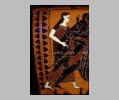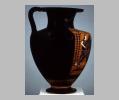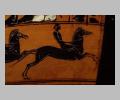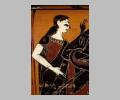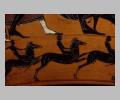| Collection: | Toledo Museum of Art |
| Summary: | Main panel: Herakles and Triton. Shoulder: apotheosis of Herakles. Predella: five horsemen racing. |
| Ware: | Attic Black Figure |
| Painter: | Attributed to the Painter of Vatican G 43 |
| Context: | From Vulci |
| Date: | ca. 530 BC |
| Dimensions: | H. to rim 0.437 m., d. rim 0.24 m., d. shoulder 0.31 m., d. foot 0.165 m. |
| Primary Citation: | |
| Shape: | Hydria |
| Region: | Etruria |
| Period: | Archaic |
Condition:
Added white mostly modern.
Decoration Description:
Herakles and Triton. Wrestling Triton in the center of the scene, Herakles straddles his body and holds him around the chest, with his hands locked together. Triton, his body pointing right with his head turned back to the left, has grabbed Herakles by the wrists to break his hold. Three dolphins are swimming right underneath the two wrestling figures. Herakles is wearing his lionskin, a chitoniskos and scabbard. On the left, behind Triton's tail, stand a Nereid and Poseidon, the Nereid in fillet, peplos and himation, and Poseidon wearing a himation and carrying his trident. Both figures on the left bend toward the action with their arms upraised, in gestures that indicate their involvement with its outcome. On the right are standing an old man (possibly Nereus) and a second Nereid. The old man wears a chiton and himation and is leaning on a staff, while the second Nereid is dressed like the first. These two onlookers stand straight and appear much less involved in the action than the two on the left.
Added red is used for the first Nereid's fillet, peplos, and the dots on her himation, Poseidon's front hair, beard, nipple, and two folds of his himation, Triton's front hair, beard, nipples, the dots in his scales, and the base and edge of his tail, Herakles' face, skirt, and chiton, the old man's fillet, himation and the dots on his chiton, the second Nereid's fillet, peplos skirt, the dots on her himation, and one dot on the first and second dolphins. Added white includes the flesh of the two Nereids, a stripe running from Triton's breast to his tail, the hair, beard and eyebrow of the old man, and dots that encircle the red dots on all figures' clothing.
Shoulder: apotheosis of Herakles. In the center, Athena is mounting a chariot, holding the reins in both hands and a spear in her right hand. She is wearing a peplos, aegis, and a high-crested Attic helmet which extends beyond the upper border of the scene. She, the chariot, and the horses face right, and Hermes approaches her, facing left, behind the horses. He wears a pilos, chitoniskos, chlamys and boots. He reaches forward and upward with his right hand and holds a kerykeion in his left. Holding club and bow and dressed in his lionskin, chitoniskos, and scabbard with sword, Herakles stands in front of the horses; he faces left. Behind him on the far right stands a woman wearing fillet, peplos and himation, with her stiffly posed arm raised toward her mouth. Behind Athena on the left Dionysos stands in chiton and himation, wearing an ivy wreath and holding a keros in his right hand. Both he and the figure behind him on the far left face the center of the scene. This latter figure is a woman in peplos and himation over her head; she holds a wreath in her upraised left hand.
On the shoulder added red occurs in folds or selected areas of clothing on all the figures, part of the chariot, the breast band and tail of the near horse, both horses' manes and part of the yoke, Dionysos's wreath and the top of his keros, the cords that secure Hermes's hat, a dot on Herakles's scabbard and part of the head on his lionskin, and the fillet of the woman behind him on the right. Added white shows on the flesh of the three females, parts of Athena's helmet crest, and the crown of Hermes's hat.
Predella: five horsemen race to the right. Each horse appears to be leaping off the ground, with only the hind legs touching the base line of the scene. The horses' manes and tails have added red.
Above the shoulder scene is a band of alternating red and black tongues circling the base of the neck. The main panel is bounded on the sides by a double row of ivy leaves. Two bands of added red appear below the predella; underneath the lower are rays circling the base.
Collection History: Ex collections Durand and Pourtalès
Sources Used:
Other Bibliography:
